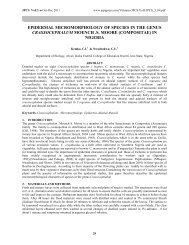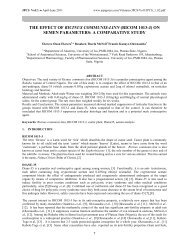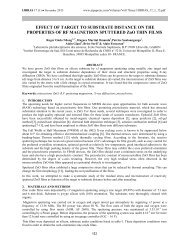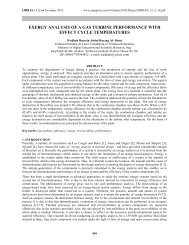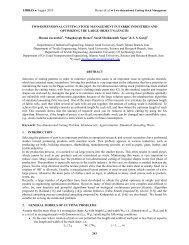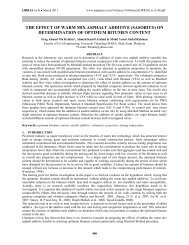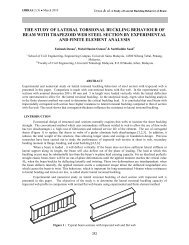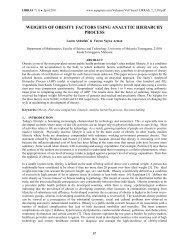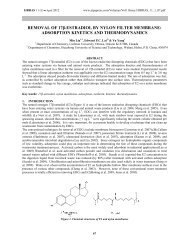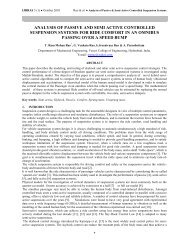elastic anisotropy of hcp metal crystals and polycrystals
elastic anisotropy of hcp metal crystals and polycrystals
elastic anisotropy of hcp metal crystals and polycrystals
You also want an ePaper? Increase the reach of your titles
YUMPU automatically turns print PDFs into web optimized ePapers that Google loves.
IJRRAS 6 (4) ● March 2011 Tromans ● Elastic Anisotropy <strong>of</strong> Hcp Metal Crystals <strong>and</strong> Poly<strong>crystals</strong><br />
others have equal values. The resulting effect for hexagonal crystal structures <strong>of</strong> all classes is to reduce the number<br />
<strong>of</strong> independent <strong>elastic</strong> constants to six [Voigt, 1928; Nye, 1985; Hearmon, 1979], as shown in the symmetrical 6 x 6<br />
matrices in Eq. (8):<br />
1<br />
C11<br />
C12<br />
C13<br />
1<br />
1<br />
S11<br />
S12<br />
S13<br />
1<br />
<br />
<br />
<br />
<br />
<br />
2<br />
<br />
C12<br />
C11<br />
C <br />
<br />
<br />
<br />
<br />
<br />
13<br />
2 <br />
2<br />
<br />
S12<br />
S11<br />
S13<br />
<br />
<br />
2<br />
<br />
<br />
<br />
<br />
3 C13<br />
C13<br />
C33<br />
3 <br />
<br />
<br />
<br />
3 S13<br />
S13<br />
S33<br />
3<br />
<br />
<br />
<br />
<br />
<br />
(8)<br />
4<br />
<br />
C44<br />
<br />
4<br />
<br />
4<br />
<br />
S44<br />
4<br />
<br />
<br />
<br />
<br />
<br />
5<br />
C<br />
<br />
<br />
<br />
44<br />
5<br />
<br />
<br />
<br />
<br />
5 S44<br />
5<br />
<br />
<br />
<br />
<br />
6<br />
<br />
<br />
C66<br />
<br />
6<br />
<br />
<br />
6<br />
<br />
<br />
S66<br />
<br />
6<br />
<br />
C66 ( C11<br />
C12)<br />
/ 2<br />
S66 2( S11<br />
S12)<br />
The 6 x 6 matrices in Eq. (8) are related to each other via matrix inversion. Consequently if the compliances (Smn)<br />
are known then the corresponding stiffness constants (Cmn) may be obtained via matrix inversion <strong>and</strong> vice versa.<br />
This is important because initial compliance measurements were most easily measured via static techniques such as<br />
bending <strong>and</strong> torsion tests [Hearmon, 1946] whereas stiffness may not be measured in this manner (e.g. it is difficult<br />
to conduct a static tensile test for a uniaxial strain situation because three orthogonal stresses are necessary).<br />
However, experiments involving propagation <strong>of</strong> longitudinal <strong>and</strong> transverse <strong>elastic</strong> waves allow measurement <strong>of</strong> the<br />
Cmn because the tensile stiffness in a specific direction is related to the density <strong>of</strong> the test material <strong>and</strong> the velocity <strong>of</strong><br />
the longitudinal wave in the same direction [Rowl<strong>and</strong> <strong>and</strong> White, 1972; Gebr<strong>and</strong>e, 1982; Blessing, 1990; Lim et al.<br />
2001]. Similarly, the shear stiffness on a specific plane is related to the velocity <strong>of</strong> the shear wave on that plane <strong>and</strong><br />
the density <strong>of</strong> the test material.<br />
3. METAL HCP CRYSTALS<br />
3.1. Crystallography.<br />
The crystallographic nature <strong>of</strong> the hexagonal <strong>metal</strong> structures is shown in Fig. 3. The unit cell in (a) has two axes a1<br />
<strong>and</strong> a2 <strong>of</strong> equal length inclined at 60 o , <strong>and</strong> an orthogonal axis <strong>of</strong> different length c. Fig. 3(b) shows the principal<br />
crystallographic directions in the (0001) basal plane expressed in the Miller-Bravais system [Cullity, 1956] using<br />
four axes composed <strong>of</strong> three planar a-axes (a1 = a2 = a3) at 120 o to each other <strong>and</strong> the orthogonal c-axis. Fig 3(c)<br />
shows the relationship between the orthogonal X-axes in Fig. 1 <strong>and</strong> crystallographic directions.<br />
a 1<br />
c<br />
a 2<br />
a 1<br />
90 o<br />
c<br />
90 o<br />
120 o<br />
a 2<br />
- [1210]<br />
--<br />
[1120] - [2110]<br />
a 3<br />
465<br />
- [1100]<br />
- - [1210]<br />
- [0110]<br />
a 2<br />
x 1<br />
90 o<br />
[0001]<br />
x3 o<br />
90 o<br />
90 o<br />
x2 - [0110]<br />
a 1= a 2= a3<br />
[2110] --<br />
a1 - [1010]<br />
- [1120]<br />
--<br />
[2110]<br />
(a) (b) (c)<br />
Figure 3 HCP <strong>metal</strong> crystallography.(a) Unit cell showing the a1, a2, <strong>and</strong> c-axes. (b) Directions in Miller-Bravais indices.<br />
(c) Relationship between X1, X2 <strong>and</strong> X3 axes in Figure 1 <strong>and</strong> crystallographic directions.<br />
When defining <strong>and</strong> measuring compliance <strong>and</strong> stiffness constants it is most important that the orthogonal axes X1 X2<br />
<strong>and</strong> X3 in Fig.1 conform to st<strong>and</strong>ardised orthogonal directions in the HCP <strong>crystals</strong> (Nye). These directions are shown<br />
in Fig 3(c) where X1 = [ 21<br />
10]<br />
i.e. the a1-axis, X2 = [ 011<br />
0]<br />
<strong>and</strong> X3 = [0001] i.e. the c-axis. All S <strong>and</strong> C constants<br />
are reported with respect to these axial directions. For example in Fig.1, <strong>and</strong> correspond to tensile stresses<br />
<strong>and</strong> strains in the [0001] direction <strong>and</strong> S33 <strong>and</strong> C33 correspond to the compliance <strong>and</strong> stiffness constants, respectively,<br />
measured in the [0001] direction.<br />
3.2. HCP Metals Examined.<br />
Twenty four hexagonal structured <strong>metal</strong>s with an atomic number (At. No.) ranging from 4 to 81were examined. All<br />
belong to the crystal class P63/mmc. They are listed in Table 1 in order <strong>of</strong> their At. No., together with their c/a ratio<br />
<strong>and</strong> density (ρ) obtained from Metals H<strong>and</strong>book [1985]. The ideal c/a ratio required for close packing <strong>of</strong> spheres to<br />
form the HCP structure is 1.633 (i.e. 24 / 3).



